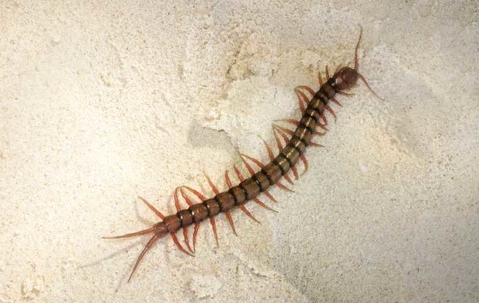Centipedes are elongated arthropods belonging to the class Chilopoda, and their appearance can vary depending on the species. Here is a description of the general characteristics of centipedes:
Centipedes typically have a long, segmented body, which can range from a few centimeters to several inches in length, depending on the species. They are dorsoventrally flattened, meaning their bodies are flattened from top to bottom. The number of body segments varies, but it's often between 15 to 177 segments. Each segment usually bears a pair of legs. These legs are one of the most distinctive features of centipedes. They are numerous and extend along the sides of the body.
The head of a centipede is well-developed and equipped with a pair of prominent, multifaceted compound eyes, although their vision is limited. Centipedes also possess a pair of modified front legs called "forcipules" or "maxillipeds," which are adapted for injecting venom into their prey. These venomous appendages are located just behind the head and are used to immobilize and subdue their prey, which mainly consists of insects, spiders, and other small arthropods.
Centipedes come in various colors, including shades of brown, reddish-brown, and even some vibrant hues. Their exoskeleton, or outer covering, is tough and provides protection. Some species may have patterns or markings on their bodies, which can serve as a form of camouflage in their natural habitats.
How Big Are Centipedes?
The size of centipedes can vary significantly depending on the species. Centipedes can range in size from very small to relatively large. Here is an overview of the size range of centipedes:
- Small Centipedes: Some centipede species are quite small, measuring only a few centimeters in length. These tiny centipedes may be around 1 to 3 centimeters (0.4 to 1.2 inches) long. They are often found in leaf litter, soil, and other concealed habitats.
- Medium-Sized Centipedes: Many centipede species fall into the medium-sized category. These centipedes typically measure between 5 to 15 centimeters (2 to 6 inches) in length. They are commonly encountered in gardens, under rocks, and in damp environments.
- Large Centipedes: Some centipede species can grow to be relatively large. These centipedes can reach lengths of 20 to 30 centimeters (8 to 12 inches) or even more in some cases. Large centipedes are more commonly found in tropical regions and may have a more potent venom compared to smaller species.
Centipede size can also vary based on factors such as their age, diet, and environmental conditions. While the size range mentioned above covers most centipede species, there may be exceptions, and some particularly large or small species may exist.
Centipede Color
Centipedes can exhibit a range of colors, and their coloration can vary depending on the species, their habitat, and even individual variations. Here is an overview of the colors that centipedes can be:
- Earthy Tones: Many centipede species are various shades of brown, from light tan to dark brown. These earthy colors often help them blend into their natural habitats, such as leaf litter and soil.
- Reddish-Brown: A common coloration among centipedes is a reddish-brown hue. This color can vary in intensity, with some centipedes having a deep reddish-brown coloration.
- Yellow and Orange: Some centipedes can be yellow or orange. These vibrant hues are less common but can be found in certain species.
- Green: Green centipedes are relatively rare, but they do exist. Their green coloration can provide camouflage in vegetation-rich environments.
- Gray and Black: While less common, there are centipede species with gray or black coloration. These colors can also help them blend into darker or shaded areas.
- Mottled or Patterned: Some centipedes may have mottled or patterned coloration, including stripes, spots, or other markings. These patterns can vary greatly between species.
- Bright Colors: In tropical regions, you may find centipede species with bright and striking colors, including blues and greens. These colors can serve as a warning to potential predators, indicating that the centipedes may be venomous.
- Iridescent: In certain species, the exoskeleton of centipedes can have an iridescent or metallic quality, reflecting a range of colors when viewed from different angles.
Centipede coloration can also change slightly as they molt and grow. Additionally, some species may have variations in color within the same population. While the colors mentioned here cover the general spectrum of centipede coloration, there may be exceptions and unique variations among different species and individuals.

